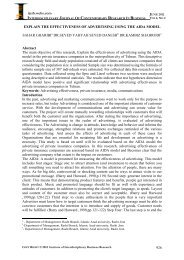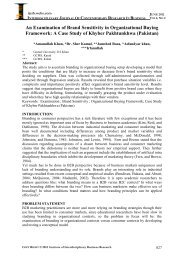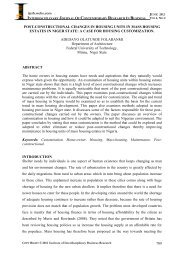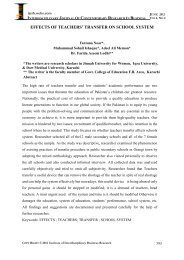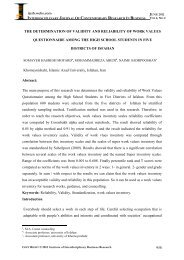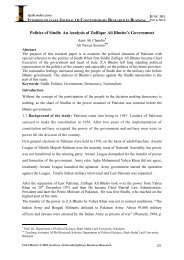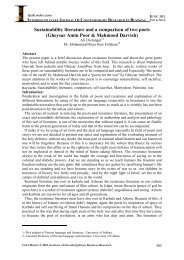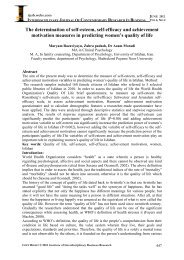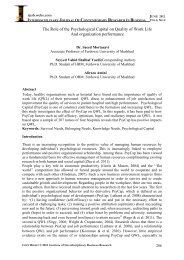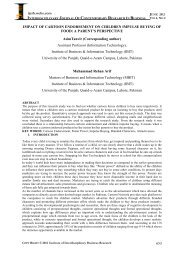The Impact of Human Resource Management Practices on - journal ...
The Impact of Human Resource Management Practices on - journal ...
The Impact of Human Resource Management Practices on - journal ...
You also want an ePaper? Increase the reach of your titles
YUMPU automatically turns print PDFs into web optimized ePapers that Google loves.
ijcrb.webs.com<br />
INTERDISCIPLINARY JOURNAL OF CONTEMPORARY RESEARCH IN BUSINESS<br />
<str<strong>on</strong>g>The</str<strong>on</strong>g> <str<strong>on</strong>g>Impact</str<strong>on</strong>g> <str<strong>on</strong>g>of</str<strong>on</strong>g> <str<strong>on</strong>g>Human</str<strong>on</strong>g> <str<strong>on</strong>g>Resource</str<strong>on</strong>g> <str<strong>on</strong>g>Management</str<strong>on</strong>g> <str<strong>on</strong>g>Practices</str<strong>on</strong>g> <strong>on</strong><br />
Employees’ Turnover Intenti<strong>on</strong>: A C<strong>on</strong>ceptual Model<br />
Choi Sang L<strong>on</strong>g (Corresp<strong>on</strong>ding Author)<br />
Faculty <str<strong>on</strong>g>of</str<strong>on</strong>g> <str<strong>on</strong>g>Management</str<strong>on</strong>g> & <str<strong>on</strong>g>Human</str<strong>on</strong>g> <str<strong>on</strong>g>Resource</str<strong>on</strong>g> Development,<br />
Universiti Teknologi Malaysia, 81310 Skudai-Johor Bahru<br />
(MALAYSIA)<br />
Panniruky Perumal<br />
Centre for Graduate Studies,<br />
Wawasan Open University<br />
(MALAYSIA)<br />
Musibau Akintunde Ajagbe<br />
Faculty <str<strong>on</strong>g>of</str<strong>on</strong>g> <str<strong>on</strong>g>Management</str<strong>on</strong>g> & <str<strong>on</strong>g>Human</str<strong>on</strong>g> <str<strong>on</strong>g>Resource</str<strong>on</strong>g> Development,<br />
Universiti Teknologi Malaysia, 81310 Skudai-Johor Bahru<br />
(MALAYSIA)<br />
COPY RIGHT © 2012 Institute <str<strong>on</strong>g>of</str<strong>on</strong>g> Interdisciplinary Business Research<br />
JUNE 2012<br />
VOL 4, NO 2<br />
Abstract<br />
It is important for human resource (HR) managers to overcome employees’ turnover<br />
intenti<strong>on</strong>. Issues encountered may be in the areas <str<strong>on</strong>g>of</str<strong>on</strong>g> shrinking pool <str<strong>on</strong>g>of</str<strong>on</strong>g> entry-level workers,<br />
individual differences, use <str<strong>on</strong>g>of</str<strong>on</strong>g> temporary workers, productivity and competitiveness,<br />
retirement benefits and skills development. <str<strong>on</strong>g>The</str<strong>on</strong>g>refore, this paper discusses extensively <strong>on</strong> the<br />
impact <str<strong>on</strong>g>of</str<strong>on</strong>g> human resource practices that can alter the negative effect <strong>on</strong> the organizati<strong>on</strong> due<br />
to high employees’ turnover. Several previous researches <strong>on</strong> this issue have been discussed in<br />
this paper to enable authors to develop a c<strong>on</strong>ceptual framework and five propositi<strong>on</strong>s.<br />
Keywords: Turnover intenti<strong>on</strong>; Career development; Employee relati<strong>on</strong>s; Performance<br />
management; compensati<strong>on</strong>.<br />
1.0 Introducti<strong>on</strong><br />
Turnover is defined as the “individual movement across the membership boundary <str<strong>on</strong>g>of</str<strong>on</strong>g> an<br />
Organizati<strong>on</strong>” (Price, 2001; Thwala et al., 2012). Interestingly unlike actual turnover,<br />
turnover intent is not explicit. Intenti<strong>on</strong>s are a statement about a specific behaviour <str<strong>on</strong>g>of</str<strong>on</strong>g> interest<br />
(Berndt, 1981).<br />
Studies have shown that turnover is <strong>on</strong>e <str<strong>on</strong>g>of</str<strong>on</strong>g> the most researched phenomena in organizati<strong>on</strong>al<br />
behaviour (Price, 2001). <str<strong>on</strong>g>The</str<strong>on</strong>g> broad range <str<strong>on</strong>g>of</str<strong>on</strong>g> turnover studies is indicative <str<strong>on</strong>g>of</str<strong>on</strong>g> the significance<br />
and complexity <str<strong>on</strong>g>of</str<strong>on</strong>g> the issue. <str<strong>on</strong>g>The</str<strong>on</strong>g> phenomen<strong>on</strong> attracts interest due to its psychological<br />
dimensi<strong>on</strong>, its organizati<strong>on</strong>al significance, and its ec<strong>on</strong>omic dimensi<strong>on</strong>. Thus it is imperative<br />
for HRM managers to understand that there are several factors inherent to counter staff<br />
intenti<strong>on</strong>s or turnover. One theory specifies that employees’ decisi<strong>on</strong> to resign is influenced<br />
by two factors: their “perceived ease <str<strong>on</strong>g>of</str<strong>on</strong>g> movement”, which refers to the assessment <str<strong>on</strong>g>of</str<strong>on</strong>g><br />
perceived alternatives or opportunity and “perceived desirability <str<strong>on</strong>g>of</str<strong>on</strong>g> movement”, which is<br />
influenced for instance by job satisfacti<strong>on</strong> (Morrell et al., 2004; Abdullah et al., 2012). This<br />
describes how balance is struck both for the organizati<strong>on</strong> and its employees in terms <str<strong>on</strong>g>of</str<strong>on</strong>g><br />
inducements, such as pay, and c<strong>on</strong>tributi<strong>on</strong>s, such as work, which ensures c<strong>on</strong>tinued<br />
organizati<strong>on</strong>al efficiency. In general, when inducements are increased by the company, this<br />
629
ijcrb.webs.com<br />
INTERDISCIPLINARY JOURNAL OF CONTEMPORARY RESEARCH IN BUSINESS<br />
COPY RIGHT © 2012 Institute <str<strong>on</strong>g>of</str<strong>on</strong>g> Interdisciplinary Business Research<br />
JUNE 2012<br />
VOL 4, NO 2<br />
will lower the tendency <str<strong>on</strong>g>of</str<strong>on</strong>g> the worker to leave and vice versa (Morrell et al., 2004). At the<br />
same time, managers should also be aware that <str<strong>on</strong>g>of</str<strong>on</strong>g> the questi<strong>on</strong> whether the decisi<strong>on</strong> to leave<br />
could have been prevented by the organizati<strong>on</strong>. This is important for the planning <str<strong>on</strong>g>of</str<strong>on</strong>g><br />
interventi<strong>on</strong>s. It would be realistic to manage this turnover as unavoidable rather than spend<br />
<strong>on</strong> theorized preventive measures, such as increasing pay. <str<strong>on</strong>g>The</str<strong>on</strong>g>se losses <str<strong>on</strong>g>of</str<strong>on</strong>g> employees can also<br />
be described as “necessary causalities” (Morrell et al., 2004).<br />
<str<strong>on</strong>g>The</str<strong>on</strong>g> impact <str<strong>on</strong>g>of</str<strong>on</strong>g> <str<strong>on</strong>g>Human</str<strong>on</strong>g> <str<strong>on</strong>g>Resource</str<strong>on</strong>g> Mismanagement can have a pr<str<strong>on</strong>g>of</str<strong>on</strong>g>ound negative effect <strong>on</strong> the<br />
Organizati<strong>on</strong>. <str<strong>on</strong>g>The</str<strong>on</strong>g> expectancy theory predicts that <strong>on</strong>e level’s <str<strong>on</strong>g>of</str<strong>on</strong>g> motivati<strong>on</strong> depends <strong>on</strong> the<br />
attractiveness <str<strong>on</strong>g>of</str<strong>on</strong>g> the rewards sought and the probability <str<strong>on</strong>g>of</str<strong>on</strong>g> obtaining these rewards (Savinelli,<br />
1990) can hold sway in any current organizati<strong>on</strong> management’s objective to achieve high<br />
productivity and competitive edge in the ‘market place’. Employees desire compensati<strong>on</strong><br />
system that they perceive as being fair and commensurate with their skills and expectati<strong>on</strong>s.<br />
Pay therefore is a major c<strong>on</strong>siderati<strong>on</strong> in an organizati<strong>on</strong> because it provides employees with<br />
a tangible reward for their services as well as source <str<strong>on</strong>g>of</str<strong>on</strong>g> recogniti<strong>on</strong> and livelihood (Howard,<br />
1993; Thwala et al., 2012; Abdullah et al., 2012).<br />
2. 0 Literature Review<br />
2.1 Relati<strong>on</strong>ship between HRM <str<strong>on</strong>g>Practices</str<strong>on</strong>g> and Turnover Intenti<strong>on</strong><br />
It is important for HRM to overcome employees’ turnover intenti<strong>on</strong>. Issues encountered may<br />
be in the areas <str<strong>on</strong>g>of</str<strong>on</strong>g> shrinking pool <str<strong>on</strong>g>of</str<strong>on</strong>g> entry-level workers, individual differences, use <str<strong>on</strong>g>of</str<strong>on</strong>g><br />
temporary workers, productivity and competitiveness, retirement benefits and skills<br />
development (John, 1995). With the attracti<strong>on</strong> <str<strong>on</strong>g>of</str<strong>on</strong>g> younger and better educated workforce,<br />
there is also a growing c<strong>on</strong>cern especially in the shift <str<strong>on</strong>g>of</str<strong>on</strong>g> employees’ negotiati<strong>on</strong>s from the<br />
bargaining table to the courts as organizati<strong>on</strong>s and individuals attempt to define rights,<br />
obligati<strong>on</strong>s and resp<strong>on</strong>sibilities. Issues in this area are job entitlement, whistle-blowing,<br />
c<strong>on</strong>cern for privacy, right to manage, smoking, mandated benefits and work and family<br />
relati<strong>on</strong>ships. Managers must not forget that there is a new attitude towards work and family<br />
c<strong>on</strong>cerns and resp<strong>on</strong>sibility. Today’s individuals are not “detached” from this family c<strong>on</strong>cern<br />
and resp<strong>on</strong>sibility and therefore the days <str<strong>on</strong>g>of</str<strong>on</strong>g> an individual working for a single company<br />
throughout his career have become rare. Besides having a balance work and family life, they<br />
seek better career prospect and pay for themselves and their family (R<strong>on</strong>, 1989; Thwala et al.,<br />
2012). This where HRM c<strong>on</strong>siders day care, job sharing, parental leave, flexitime, educati<strong>on</strong><br />
and re-training and job rotati<strong>on</strong> as an incentive to balance the c<strong>on</strong>cerns besides reviewing<br />
compensati<strong>on</strong> and benefits. People are seeking many ways <str<strong>on</strong>g>of</str<strong>on</strong>g> live that is meaningful and less<br />
complicated and this new lifestyle actually has an impact <strong>on</strong> how an employee must be<br />
motivated and managed. HRM has become so complex now when it was much less<br />
complicated in the past when employees were primarily c<strong>on</strong>cerned with ec<strong>on</strong>omical survival<br />
(Brian, 1994; Myr<strong>on</strong>, 1993).<br />
2.1.1 Compensati<strong>on</strong> and Benefit<br />
In a research study by Shahzad et al. (2008), findings revealed a positive relati<strong>on</strong>ship <str<strong>on</strong>g>of</str<strong>on</strong>g><br />
reward practices with the performance <str<strong>on</strong>g>of</str<strong>on</strong>g> university teachers in Pakistan. This is important<br />
especially when countering the other factor <str<strong>on</strong>g>of</str<strong>on</strong>g> turnover intenti<strong>on</strong>s in the l<strong>on</strong>g run. It is a<br />
known fact that employees desire a compensati<strong>on</strong> system that they perceived as being fair<br />
and commensurate with their skills, experiences and knowledge. <str<strong>on</strong>g>The</str<strong>on</strong>g>refore HRM must take<br />
note that pay is the main c<strong>on</strong>siderati<strong>on</strong> because it provides the tangible rewards for the<br />
employees for their services as well as a source for recogniti<strong>on</strong> and livelihood. Employee<br />
630
ijcrb.webs.com<br />
INTERDISCIPLINARY JOURNAL OF CONTEMPORARY RESEARCH IN BUSINESS<br />
COPY RIGHT © 2012 Institute <str<strong>on</strong>g>of</str<strong>on</strong>g> Interdisciplinary Business Research<br />
JUNE 2012<br />
VOL 4, NO 2<br />
compensati<strong>on</strong> and benefits includes all form <str<strong>on</strong>g>of</str<strong>on</strong>g> pay, rewards, b<strong>on</strong>uses, commissi<strong>on</strong>s, leaves,<br />
recogniti<strong>on</strong> programs, flexi work hours and medical insurance (Sherman et al., 1998).<br />
In a study involving data from 583 participants in H<strong>on</strong>g K<strong>on</strong>g and 121 participants in China,<br />
it was revealed that compensati<strong>on</strong> comp<strong>on</strong>ents are important factors to retain and motivate<br />
employees (Randy et al., 2002). Scholars agree that the way compensati<strong>on</strong> is allocated for<br />
employees actually send messages about the management believes and what is important in<br />
the types <str<strong>on</strong>g>of</str<strong>on</strong>g> activities it encourages. Evidently in a study c<strong>on</strong>ducted <strong>on</strong> Southwest airlines by<br />
Aric (2008) <strong>on</strong> managing compensati<strong>on</strong> and rewards through organizati<strong>on</strong>al pay, he<br />
emphasized that the human resources department can use a compensati<strong>on</strong> strategy to<br />
strengthen the strategic and business strategy <str<strong>on</strong>g>of</str<strong>on</strong>g> the organizati<strong>on</strong> by enhancing individual<br />
performance. This may in turn negate turnover. This also provide the opportunity for the<br />
organizati<strong>on</strong> to explore and c<strong>on</strong>sider other n<strong>on</strong>- c<strong>on</strong>venti<strong>on</strong>al areas for implementati<strong>on</strong> in the<br />
future in ensuring job satisfacti<strong>on</strong> for the employees such as flexi time, shorter working hours<br />
and even providing child care services for the woman employees with children as part <str<strong>on</strong>g>of</str<strong>on</strong>g> the<br />
compensati<strong>on</strong> package (Jill, 2005). In fact in a research by Roya et al. (2011), <strong>on</strong> 301 n<strong>on</strong><br />
academic staff in the universities <str<strong>on</strong>g>of</str<strong>on</strong>g> medical sciences in Iran, revealed that strategic<br />
compensati<strong>on</strong> practises lead to perceived effective organizati<strong>on</strong>al commitment due to<br />
fulfilment <str<strong>on</strong>g>of</str<strong>on</strong>g> psychological c<strong>on</strong>tract that actually c<strong>on</strong>tribute to staff less likely to leave the<br />
organizati<strong>on</strong>. This is true especially in the security industry. This is traditi<strong>on</strong>ally a low paying<br />
job and the employers needs to raise starting pay to attract a sufficient number <str<strong>on</strong>g>of</str<strong>on</strong>g> applicants<br />
due to several factors, <strong>on</strong>e <str<strong>on</strong>g>of</str<strong>on</strong>g> which is l<strong>on</strong>g hours <str<strong>on</strong>g>of</str<strong>on</strong>g> work and the other is the so-called n<strong>on</strong>glamour<br />
percepti<strong>on</strong> <str<strong>on</strong>g>of</str<strong>on</strong>g> the job. Another reas<strong>on</strong> is due to the competitive labour market and<br />
low rate <str<strong>on</strong>g>of</str<strong>on</strong>g> unemployment in this regi<strong>on</strong> especially in Singapore and Malaysia which means<br />
people are able to find jobs in the more attractive industries such as the government services<br />
and tourism sectors that usually cater to their career <str<strong>on</strong>g>of</str<strong>on</strong>g> interest. <str<strong>on</strong>g>The</str<strong>on</strong>g>refore, there is a<br />
c<strong>on</strong>siderati<strong>on</strong> for employers to pay high rate and also other benefit and compensati<strong>on</strong><br />
package thus creating large pools <str<strong>on</strong>g>of</str<strong>on</strong>g> applicants and probably attract better qualified and<br />
educated employees (SAS, 2011).<br />
Roberto (2007) from the University <str<strong>on</strong>g>of</str<strong>on</strong>g> Valencia, Spain opine that salary strategies and job<br />
enrichment strategies were positively related to job satisfacti<strong>on</strong> and thus has an effect<br />
negatively <strong>on</strong> turnover intenti<strong>on</strong>s. This was mediated by positive employee commitment. As<br />
turnover c<strong>on</strong>tinues to be very serious problems in many organizati<strong>on</strong>s including the company<br />
related to this study, the research had suggested specific practises to develop strategies as an<br />
immediate step to lower turnover. In a similar survey c<strong>on</strong>ducted <strong>on</strong> 666 Thai workers, results<br />
revealed beside fairness and growth opportunities as job satisfacti<strong>on</strong> for these workers,<br />
rewards was also cited as an important criteria for job satisfacti<strong>on</strong> and negate turnover<br />
intenti<strong>on</strong> (Lobburi, 2012).<br />
2.1.2 Training<br />
Training has become increasingly vital to the success <str<strong>on</strong>g>of</str<strong>on</strong>g> any modern organizati<strong>on</strong>s.<br />
Nowadays organizati<strong>on</strong>s need to have competencies and especially core sets <str<strong>on</strong>g>of</str<strong>on</strong>g> knowledge<br />
and expertise that will give the companies an edge over its competitors. <str<strong>on</strong>g>The</str<strong>on</strong>g> <strong>on</strong>ly way to<br />
arrive at this is through having a dedicated training program that plays a central role to<br />
nurture and strengthen these competencies (Sherman et al., 1998). It is acknowledged that<br />
training forms the backb<strong>on</strong>e <str<strong>on</strong>g>of</str<strong>on</strong>g> strategy implementati<strong>on</strong> and that industries such as the<br />
security industry must have trained security <str<strong>on</strong>g>of</str<strong>on</strong>g>ficers, who must be competent in the basic<br />
laws, rescue operati<strong>on</strong>s, emergencies resp<strong>on</strong>se and also crowd c<strong>on</strong>trol and public<br />
631
ijcrb.webs.com<br />
INTERDISCIPLINARY JOURNAL OF CONTEMPORARY RESEARCH IN BUSINESS<br />
COPY RIGHT © 2012 Institute <str<strong>on</strong>g>of</str<strong>on</strong>g> Interdisciplinary Business Research<br />
JUNE 2012<br />
VOL 4, NO 2<br />
management to be able to perform their job. <str<strong>on</strong>g>The</str<strong>on</strong>g> lack <str<strong>on</strong>g>of</str<strong>on</strong>g> these will definitely result in<br />
complaints, further injuries to public and damages to properties. It has always been extolled<br />
in law enforcement manual and frequently heard sayings that law enforcement agencies must<br />
always be <strong>on</strong>e step ahead <str<strong>on</strong>g>of</str<strong>on</strong>g> the criminals and would be perpetrators to be able to prevent<br />
crimes and what better ways can <str<strong>on</strong>g>of</str<strong>on</strong>g>ficers be prepared if not through c<strong>on</strong>tinuous training to<br />
h<strong>on</strong>e the <str<strong>on</strong>g>of</str<strong>on</strong>g>ficers knowledge, skills, abilities to cope with new processes and systems (Raffee,<br />
2001). To highlight the importance <str<strong>on</strong>g>of</str<strong>on</strong>g> training for new comers, research by Terry and team<br />
(2002), revealed that the H<strong>on</strong>g K<strong>on</strong>g Hotel Industry have been plague by high turnover<br />
especially am<strong>on</strong>g those who are less than a year <str<strong>on</strong>g>of</str<strong>on</strong>g> service from 1985-1999 which is between<br />
44% to 66%. Survey <str<strong>on</strong>g>of</str<strong>on</strong>g> 249 participants has emphasized that Training and job enrichment<br />
program beside other HRM practises are closely related to turnover intenti<strong>on</strong>s.<br />
Training not <strong>on</strong>ly ensures competencies but also develops employees to be able to meet<br />
organizati<strong>on</strong>s’ goals and objectives and also ensure satisfactory performance and as<br />
reiterated, to be able to acquire new skills and knowledge and perform jobs in other areas or<br />
at higher level. A research am<strong>on</strong>g 46 hotels in San Diego by the San Diego State University<br />
in 2007 to check <strong>on</strong> staff turnover intenti<strong>on</strong>s and results revealed that c<strong>on</strong>stant training and<br />
development to bring staff to an acceptable level <str<strong>on</strong>g>of</str<strong>on</strong>g> performance and keeping them engaged<br />
actually has a significant link and relati<strong>on</strong> to job satisfacti<strong>on</strong>, morale and optimism thus<br />
impacted turnover intenti<strong>on</strong>s (Chee et al., 2007; Abdullah et al., 2012; Thwala et al., 2012).<br />
Another research by RMIT University, Australia and Nottingham Trent University, U.K. <strong>on</strong><br />
high employee turnover rate am<strong>on</strong>g multinati<strong>on</strong>al companies in Asia revealed that <strong>on</strong>e <str<strong>on</strong>g>of</str<strong>on</strong>g> the<br />
main factors besides size, length <str<strong>on</strong>g>of</str<strong>on</strong>g> operati<strong>on</strong>s and nature <str<strong>on</strong>g>of</str<strong>on</strong>g> industry to be significantly<br />
related to turnover is training. <str<strong>on</strong>g>The</str<strong>on</strong>g> results were derived using samples from 529 MNCs in 6<br />
Asian countries. This is another example highlighting the importance <str<strong>on</strong>g>of</str<strong>on</strong>g> training as part <str<strong>on</strong>g>of</str<strong>on</strong>g> the<br />
human resources variables that can have significant impact <strong>on</strong> turnover (C<strong>on</strong>nie et al., 2009).<br />
<str<strong>on</strong>g>The</str<strong>on</strong>g> extent <str<strong>on</strong>g>of</str<strong>on</strong>g> the study over 6 countries and 529 organizati<strong>on</strong>s cannot deny the impact <str<strong>on</strong>g>of</str<strong>on</strong>g><br />
training over cross borders and not c<strong>on</strong>fined to an organizati<strong>on</strong> or country.<br />
Another scholar from Gadjah Mada University, Ind<strong>on</strong>esia c<strong>on</strong>ducted a research and study <str<strong>on</strong>g>of</str<strong>on</strong>g><br />
the influence <str<strong>on</strong>g>of</str<strong>on</strong>g> employee development in predicting turnover intenti<strong>on</strong>s <str<strong>on</strong>g>of</str<strong>on</strong>g> hotel employees<br />
in 2006. A total <str<strong>on</strong>g>of</str<strong>on</strong>g> 380 employees from 5-star rated hotels were asked to complete<br />
questi<strong>on</strong>naires and hierarchical regressi<strong>on</strong> analysis was used. It was revealed that <strong>on</strong>e <str<strong>on</strong>g>of</str<strong>on</strong>g> the<br />
variables <str<strong>on</strong>g>of</str<strong>on</strong>g> human resources practises <str<strong>on</strong>g>of</str<strong>on</strong>g> providing c<strong>on</strong>tinual training and development<br />
programs to the employees supported the hypothesis that training and employee development<br />
has a direct link to staff turnover intenti<strong>on</strong>s (Mohamad et al., 2006). He also further revealed<br />
that c<strong>on</strong>ducting fairly, having formal appraisal system and having clear career advancement<br />
path for employees are the other factors linking to employee turnover intenti<strong>on</strong>s.<br />
A similar study was also c<strong>on</strong>ducted at a marine engineering organizati<strong>on</strong> <strong>on</strong> American,<br />
British and Spanish employees <strong>on</strong> the subject <str<strong>on</strong>g>of</str<strong>on</strong>g> Training Envir<strong>on</strong>ments, Work Attitudes, and<br />
Turnover Intenti<strong>on</strong>. This paper reported a study <str<strong>on</strong>g>of</str<strong>on</strong>g> work attitudes am<strong>on</strong>g 732 American,<br />
British, and Spanish students undergoing training as merchant marine engineering <str<strong>on</strong>g>of</str<strong>on</strong>g>ficers.<br />
All were <str<strong>on</strong>g>of</str<strong>on</strong>g> the same age and were at the same point in their careers. Although wide<br />
differences were shown in terms <str<strong>on</strong>g>of</str<strong>on</strong>g> attitudes toward the occupati<strong>on</strong> including turnover<br />
intenti<strong>on</strong>, the finding revealed that the single most important variable was the nati<strong>on</strong>al<br />
c<strong>on</strong>text in which training was taking place (William et al., 2007). Another example is the<br />
research by the University <str<strong>on</strong>g>of</str<strong>on</strong>g> Texas by a scholar to verify the importance <str<strong>on</strong>g>of</str<strong>on</strong>g> certain training<br />
methods link to staff turnover intenti<strong>on</strong>s. Participati<strong>on</strong> in three types <str<strong>on</strong>g>of</str<strong>on</strong>g> development<br />
activities was included for examinati<strong>on</strong> am<strong>on</strong>g salaried employees <str<strong>on</strong>g>of</str<strong>on</strong>g> a firm that significantly<br />
632
ijcrb.webs.com<br />
INTERDISCIPLINARY JOURNAL OF CONTEMPORARY RESEARCH IN BUSINESS<br />
COPY RIGHT © 2012 Institute <str<strong>on</strong>g>of</str<strong>on</strong>g> Interdisciplinary Business Research<br />
JUNE 2012<br />
VOL 4, NO 2<br />
increased access to development after a series <str<strong>on</strong>g>of</str<strong>on</strong>g> lay<str<strong>on</strong>g>of</str<strong>on</strong>g>fs in the late 1990s. Analyses <str<strong>on</strong>g>of</str<strong>on</strong>g> survey<br />
and archival data representing 667 employees show that <strong>on</strong>-the-job training was positively<br />
related to organisati<strong>on</strong>al commitment and negatively related to intenti<strong>on</strong> to turnover (Bens<strong>on</strong>,<br />
2006).<br />
2.1.3 Performance <str<strong>on</strong>g>Management</str<strong>on</strong>g><br />
It cannot be denied that the success or failure <str<strong>on</strong>g>of</str<strong>on</strong>g> performance management programs <str<strong>on</strong>g>of</str<strong>on</strong>g> any<br />
organizati<strong>on</strong> depends <strong>on</strong> the philosophy that it is c<strong>on</strong>nected to business goals and the attitudes<br />
and skills <str<strong>on</strong>g>of</str<strong>on</strong>g> those resp<strong>on</strong>sible for its implementati<strong>on</strong>s and operati<strong>on</strong>s. <str<strong>on</strong>g>The</str<strong>on</strong>g>re are many<br />
methods available to gather informati<strong>on</strong> <str<strong>on</strong>g>of</str<strong>on</strong>g> an employee performance in the appraisal process.<br />
This informati<strong>on</strong> must be used for organizati<strong>on</strong>al needs and communicated to employees so<br />
that it will result in a high level performance (Chris, 1996; Thwala et al., 2012; Abdullah et<br />
al., 2012). Performance management can focus <strong>on</strong> the performance <str<strong>on</strong>g>of</str<strong>on</strong>g> an organizati<strong>on</strong>, a<br />
department, employee, or even the processes to build a product or service, as well as many<br />
other areas. It is acknowledged that a lack <str<strong>on</strong>g>of</str<strong>on</strong>g> performance appraisal can have adverse effect<br />
<strong>on</strong> employees’ motivati<strong>on</strong> and c<strong>on</strong>tribute to employees’ turnover intenti<strong>on</strong>s (Laura, 1996;<br />
Abdullah et al., 2011). An example is the research by the Nati<strong>on</strong>al University <str<strong>on</strong>g>of</str<strong>on</strong>g> Malaysia in<br />
2004, in regards to performance appraisal and employee’s percepti<strong>on</strong> and intenti<strong>on</strong> to leave.<br />
It was revealed that whenever performance appraisal is perceived by employees’ to have<br />
organizati<strong>on</strong> political motives, this affect their job satisfacti<strong>on</strong> and pr<strong>on</strong>e to turnover<br />
intenti<strong>on</strong>s (June, 2004; Abdullah et al., 2011).<br />
In a study <str<strong>on</strong>g>of</str<strong>on</strong>g> data collected from 65 studies c<strong>on</strong>ducted <strong>on</strong> performance management and<br />
turnover intenti<strong>on</strong>, results revealed that there is relati<strong>on</strong>ship between employees’ job<br />
performance management and their intenti<strong>on</strong> to quit (Zimmerman, 2009). Another research<br />
by the American Psychological Associati<strong>on</strong> in 2001, <strong>on</strong> 130 employees <str<strong>on</strong>g>of</str<strong>on</strong>g> a medical services<br />
organizati<strong>on</strong> revealed that despite the importance <str<strong>on</strong>g>of</str<strong>on</strong>g> understanding the c<strong>on</strong>diti<strong>on</strong>s under<br />
which high performing employees are more likely or less likely to voluntarily leave an<br />
organizati<strong>on</strong>, the nature <str<strong>on</strong>g>of</str<strong>on</strong>g> the relati<strong>on</strong>ship between job performance and voluntary turnover<br />
has proven to be elusive. <str<strong>on</strong>g>The</str<strong>on</strong>g>refore a model <str<strong>on</strong>g>of</str<strong>on</strong>g> the performance–turnover relati<strong>on</strong>ship that<br />
highlights important moderators and mediators was proposed and tested. Data c<strong>on</strong>sisted <str<strong>on</strong>g>of</str<strong>on</strong>g><br />
organizati<strong>on</strong>al performance and turnover records and survey resp<strong>on</strong>ses collected indicate that<br />
visibility and reward c<strong>on</strong>tingencies moderate performance relati<strong>on</strong>ships with alternatives and<br />
job satisfacti<strong>on</strong>, respectively, and that performance may influence turnover through multiple<br />
mechanisms (Allen et al., 2001). Research by Texas A& M University in 2006 <strong>on</strong> data and<br />
analysis <str<strong>on</strong>g>of</str<strong>on</strong>g> past 65 similar studies revealed that findings provide for a better understanding <str<strong>on</strong>g>of</str<strong>on</strong>g><br />
how employees' job performance affects their turnover decisi<strong>on</strong>s and how organizati<strong>on</strong>s can<br />
c<strong>on</strong>trol turnover through integrated performance management system that includes rating by<br />
supervisors and enhanced management <str<strong>on</strong>g>of</str<strong>on</strong>g> better and poor performance employees through a<br />
comprehensive appraisal system (Ryan et al., 2006).<br />
2.1.4 Career Development<br />
Career development in an organizati<strong>on</strong> should be viewed as a very dynamic process that<br />
attempts to meet the needs <str<strong>on</strong>g>of</str<strong>on</strong>g> managers, subordinates and the organizati<strong>on</strong>. It is the<br />
resp<strong>on</strong>sibility <str<strong>on</strong>g>of</str<strong>on</strong>g> managers to encourage employees to take resp<strong>on</strong>sibility for their own<br />
careers, <str<strong>on</strong>g>of</str<strong>on</strong>g>fering c<strong>on</strong>tinuous assistance in the form <str<strong>on</strong>g>of</str<strong>on</strong>g> feedback or individual performance and<br />
making available informati<strong>on</strong> from the company about the organizati<strong>on</strong>, career opportunities,<br />
633
ijcrb.webs.com<br />
INTERDISCIPLINARY JOURNAL OF CONTEMPORARY RESEARCH IN BUSINESS<br />
COPY RIGHT © 2012 Institute <str<strong>on</strong>g>of</str<strong>on</strong>g> Interdisciplinary Business Research<br />
JUNE 2012<br />
VOL 4, NO 2<br />
positi<strong>on</strong>s and vacancies that might be <str<strong>on</strong>g>of</str<strong>on</strong>g> interest to the employees (Zandy et al., 1986). It<br />
cannot be denied that in career development process, the organizati<strong>on</strong> must supply adequate<br />
informati<strong>on</strong> about its missi<strong>on</strong>, policies, and support for self assessment, training and<br />
development. It is important to note that significant career growth can occur when individual<br />
c<strong>on</strong>tributi<strong>on</strong> combines with organizati<strong>on</strong> opportunity. Increase in skills and the opportunity to<br />
manage their career successfully helps to retained valued employees (Sherman et al., 1998).<br />
A study was carried out by Ming Chuan University in Taiwan <strong>on</strong> R&D pers<strong>on</strong>nel to explore<br />
the career needs and proposes the c<strong>on</strong>cept <str<strong>on</strong>g>of</str<strong>on</strong>g> the gap between career development programs<br />
and career needs, and its subsequent effect <strong>on</strong> job satisfacti<strong>on</strong> and turnover intenti<strong>on</strong>. A set <str<strong>on</strong>g>of</str<strong>on</strong>g><br />
questi<strong>on</strong>naires were completed by 367 R&D pers<strong>on</strong>nel. <str<strong>on</strong>g>The</str<strong>on</strong>g> results reveal that R&D<br />
pers<strong>on</strong>nel have very diverse career needs at various stages <str<strong>on</strong>g>of</str<strong>on</strong>g> their career. Depending <strong>on</strong><br />
which stage <str<strong>on</strong>g>of</str<strong>on</strong>g> their career they have reached, the larger the gap, the higher the levels <str<strong>on</strong>g>of</str<strong>on</strong>g> both<br />
turnover intenti<strong>on</strong>s and job dissatisfacti<strong>on</strong> (Tser et al., 2004). In another study c<strong>on</strong>ducted by<br />
scholars <strong>on</strong> the nursing industry in the USA, the subject was to examine the relati<strong>on</strong>ships<br />
between work satisfacti<strong>on</strong> from career development, stress, age, cohesi<strong>on</strong>, work schedule,<br />
and anticipated turnover in an academic medical centre. Questi<strong>on</strong>naires were used to get<br />
feedback from staff <str<strong>on</strong>g>of</str<strong>on</strong>g> the 908 bed university hospital and results revealed that job<br />
satisfacti<strong>on</strong> derived from an established career development program and putting people in<br />
the right job and resp<strong>on</strong>sibility actually reduce stress because <str<strong>on</strong>g>of</str<strong>on</strong>g> better cohesi<strong>on</strong> and work<br />
schedule management. This in turn has significant relati<strong>on</strong> to staff retenti<strong>on</strong> and negate<br />
turnover intenti<strong>on</strong>s (Shader et al., 2001).<br />
Similarly, a study <strong>on</strong> Informati<strong>on</strong> System Auditors in the US revealed that pr<str<strong>on</strong>g>of</str<strong>on</strong>g>essi<strong>on</strong>al<br />
growth related to career progressi<strong>on</strong> was related to turnover intenti<strong>on</strong>s and thus the<br />
companies were advised to have regular career advancement opportunities and pr<str<strong>on</strong>g>of</str<strong>on</strong>g>essi<strong>on</strong>al<br />
growth for its staff in a bid to retain them (Muliawan, 2009). As career development involves<br />
an organized, formalized, planned effort to achieve a balance between an individual’s career<br />
needs and the organizati<strong>on</strong>’s workforce requirements, it is important for an organizati<strong>on</strong><br />
commitment in the program (Lips & Hall, 2007). To highlight these theories further, let’s<br />
look at another research which was c<strong>on</strong>ducted by the University <str<strong>on</strong>g>of</str<strong>on</strong>g> Haifa <str<strong>on</strong>g>of</str<strong>on</strong>g> Israel <strong>on</strong> the<br />
turnover intenti<strong>on</strong>s <str<strong>on</strong>g>of</str<strong>on</strong>g> welfare workers. <str<strong>on</strong>g>The</str<strong>on</strong>g> predictors were commitment and job satisfacti<strong>on</strong>.<br />
It was verified that welfare organizati<strong>on</strong>s serve as an example <str<strong>on</strong>g>of</str<strong>on</strong>g> the importance <str<strong>on</strong>g>of</str<strong>on</strong>g> job<br />
involvement and organizati<strong>on</strong>al commitment to promote pr<str<strong>on</strong>g>of</str<strong>on</strong>g>essi<strong>on</strong>al and effective work and<br />
such goals is very important for employees’ career commitment and job satisfacti<strong>on</strong>. A total<br />
<str<strong>on</strong>g>of</str<strong>on</strong>g> 330 resp<strong>on</strong>dents were involved and result revealed that career commitment and job<br />
satisfacti<strong>on</strong> actually has a significant effect <strong>on</strong> reversing turnover intenti<strong>on</strong>s (Anna, 2008).<br />
Furthermore a study <strong>on</strong> 442 design engineers, revealed that the existence <str<strong>on</strong>g>of</str<strong>on</strong>g> career<br />
advancement within the organizati<strong>on</strong> actually lower turnover intenti<strong>on</strong>s (Barbara, 2012).<br />
Similar study by University <str<strong>on</strong>g>of</str<strong>on</strong>g> Technology MARA, Malaysia, <strong>on</strong> 380 employees from 5-star<br />
hotels revealed that besides having good HR practises, other predictors such as career<br />
advancement program is essential to negate turnover intenti<strong>on</strong>s (Helmi, 2006).<br />
2.1.5 Employee Relati<strong>on</strong>s<br />
Using the underlying social exchange theory (Blau, 1964) and the norm <str<strong>on</strong>g>of</str<strong>on</strong>g> reciprocity<br />
(Gouldner, 1960), Eisenberger (1986) it was suggested that individual attitudes and<br />
behaviours are affected by generalized percepti<strong>on</strong> <str<strong>on</strong>g>of</str<strong>on</strong>g> care and support from organizati<strong>on</strong>s.<br />
Employees feel obliged to repay organizati<strong>on</strong> with extra effort and loyalty when such<br />
favourable supportive treatments are discreti<strong>on</strong>ary-based (Eisenberger et al., 2001). This is<br />
634
ijcrb.webs.com<br />
INTERDISCIPLINARY JOURNAL OF CONTEMPORARY RESEARCH IN BUSINESS<br />
COPY RIGHT © 2012 Institute <str<strong>on</strong>g>of</str<strong>on</strong>g> Interdisciplinary Business Research<br />
JUNE 2012<br />
VOL 4, NO 2<br />
emphasised in a study <strong>on</strong> 437 Chinese employees from multinati<strong>on</strong>al companies revealed that<br />
perceived supervisory support has a direct relati<strong>on</strong> to turnover intenti<strong>on</strong>s (Alexander, 2012).<br />
Employee relati<strong>on</strong>s in an organizati<strong>on</strong> is simply described as maintaining a healthy working<br />
relati<strong>on</strong>ship between management and employees to c<strong>on</strong>tribute and sustain a satisfactory<br />
productivity, motivati<strong>on</strong> and high morale work envir<strong>on</strong>ment that enhance job satisfacti<strong>on</strong> for<br />
the employee and meet goals <str<strong>on</strong>g>of</str<strong>on</strong>g> the organizati<strong>on</strong>. Workplace employer-employee relati<strong>on</strong>ship<br />
will be the employment topics into the 20 th century especially when there are growing<br />
attenti<strong>on</strong> to employee rights. This is more so when the need arises to balance employee rights<br />
and employee discipline. Managers have reported that it has become very stressful and<br />
unpleasant for managers and supervisors when they need to mete out disciplinary acti<strong>on</strong>s. In<br />
today’s organizati<strong>on</strong>s’ c<strong>on</strong>text <str<strong>on</strong>g>of</str<strong>on</strong>g> discipline, most opt for counselling rather than punishment<br />
to achieve individual and organizati<strong>on</strong>al objectives (Sherman et al., 1998). As more and more<br />
businesses recognise the enthusiastic and committed employees add value to their<br />
organizati<strong>on</strong> not just in terms <str<strong>on</strong>g>of</str<strong>on</strong>g> productivity but also customer satisfacti<strong>on</strong>, retenti<strong>on</strong>,<br />
pr<str<strong>on</strong>g>of</str<strong>on</strong>g>itability and l<strong>on</strong>g term stakeholder value, employee engagement is the most important<br />
criteria c<strong>on</strong>cerning management <str<strong>on</strong>g>of</str<strong>on</strong>g> any organizati<strong>on</strong> today (Cook, 2008).<br />
Employee relati<strong>on</strong> has been aptly menti<strong>on</strong>ed as a communicati<strong>on</strong> process to train, correct,<br />
mould, perfect the knowledge, attitudes, behaviour and c<strong>on</strong>duct <str<strong>on</strong>g>of</str<strong>on</strong>g> employees and that a good<br />
discipline management tool can correct poor employee performance rather than use as a<br />
punishment and this actually enhanced leadership and supervisory quality <str<strong>on</strong>g>of</str<strong>on</strong>g> managers<br />
(D<strong>on</strong>ald et al., 1997). In a research article by Rebecca (2012), from Oklahoma State<br />
University, a study was undertaken in regards to c<strong>on</strong>diti<strong>on</strong> under which supervisor<br />
undermining is related to percepti<strong>on</strong>s <str<strong>on</strong>g>of</str<strong>on</strong>g> leader hypocrisy that then lead to employee turnover<br />
intenti<strong>on</strong>s. Based <strong>on</strong> 200 scenario-based experiments and 300 survey based study, the results<br />
revealed a general support to the author’s hypothesis that supervisors hypocritical behaviours<br />
do motivate staff turnover intenti<strong>on</strong>s.<br />
On the other hand, employees today are dealing with more complicated work tasks, <str<strong>on</strong>g>of</str<strong>on</strong>g>ten<br />
work l<strong>on</strong>g hours, and work in teams (Lee, 2004). <str<strong>on</strong>g>The</str<strong>on</strong>g>y might require higher socio-emoti<strong>on</strong>al<br />
and growth needs that motivate them to work and perform better in their work tasks. As<br />
supervisors play an important role in managing employees and projects, their relati<strong>on</strong>s are<br />
much closer. Hence, beneficial treatment from a supervisor could increase perceived<br />
organizati<strong>on</strong>al support to the extent that such treatment is discreti<strong>on</strong>ary, fair, and attributed to<br />
the organizati<strong>on</strong>’s policies and procedures (Rhoades et al., 2001). This is expected to<br />
ultimately lead to negative turnover intenti<strong>on</strong>s and increase productivity and efficiency<br />
coupled with job satisfacti<strong>on</strong> and performance ( Cott<strong>on</strong> et al, 1986; Lee, 2004; Thwala et al.,<br />
2012). A study by Nagoya University, at a Korean Hospital indicated that staffs seek career<br />
success through their relati<strong>on</strong>ship with their supervisors and see positive relati<strong>on</strong>ship as an<br />
organizati<strong>on</strong>al commitment and leads to job satisfacti<strong>on</strong>s. This in turn negates turnover<br />
intenti<strong>on</strong>s (Fo<strong>on</strong>g, 2008). This also highlights the importance <str<strong>on</strong>g>of</str<strong>on</strong>g> employee relati<strong>on</strong>s. Another<br />
similar study was also carried out by the Norwegian School <str<strong>on</strong>g>of</str<strong>on</strong>g> <str<strong>on</strong>g>Management</str<strong>on</strong>g> <strong>on</strong> 593<br />
employees from 64 banks. <str<strong>on</strong>g>The</str<strong>on</strong>g> study was c<strong>on</strong>ducted to examine whether and how quality<br />
employee-organizati<strong>on</strong>al relati<strong>on</strong>ship influence turnover intenti<strong>on</strong>s. Results indicated a str<strong>on</strong>g<br />
negative relati<strong>on</strong> between positive employee relati<strong>on</strong>s as an HR practises against turnover<br />
intenti<strong>on</strong>s. This proves that positive employee-employer relati<strong>on</strong>ship has positive employee<br />
outcomes (Kuvaas, 2006).<br />
It is noted that the role and support <str<strong>on</strong>g>of</str<strong>on</strong>g> top management is also critical and important criteria<br />
in ensuring a robust and good employee relati<strong>on</strong> management system in place. Recent<br />
635
ijcrb.webs.com<br />
INTERDISCIPLINARY JOURNAL OF CONTEMPORARY RESEARCH IN BUSINESS<br />
COPY RIGHT © 2012 Institute <str<strong>on</strong>g>of</str<strong>on</strong>g> Interdisciplinary Business Research<br />
JUNE 2012<br />
VOL 4, NO 2<br />
findings in transformati<strong>on</strong>al leadership research prescribe top management to develop and<br />
share a visi<strong>on</strong> for the organizati<strong>on</strong>, model that visi<strong>on</strong>, encourage innovativeness, support<br />
employee efforts, and allow employees input into decisi<strong>on</strong>s c<strong>on</strong>cerning their jobs (Kouzes et<br />
al, 1988). In a survey <strong>on</strong> 279 young pr<str<strong>on</strong>g>of</str<strong>on</strong>g>essi<strong>on</strong>als in china where a str<strong>on</strong>g link <strong>on</strong> loyalty to<br />
organizati<strong>on</strong> and turnover intenti<strong>on</strong> was listed as a str<strong>on</strong>g predictor (Bu, 2011) and another<br />
study <str<strong>on</strong>g>of</str<strong>on</strong>g> 1187 registered nurses in the west revealed that unsupportive work envir<strong>on</strong>ment and<br />
poor leadership quality which is an indicator <str<strong>on</strong>g>of</str<strong>on</strong>g> poor employee and employer relati<strong>on</strong>ship<br />
have implicati<strong>on</strong> for nurses to resign in a year (Beatrice, 2009).<br />
3. 0 C<strong>on</strong>ceptual Framework<br />
<str<strong>on</strong>g>The</str<strong>on</strong>g> framework comp<strong>on</strong>ents outlined (see fig. 1) c<strong>on</strong>sist <str<strong>on</strong>g>of</str<strong>on</strong>g> the independent variables, which<br />
are the causal factors, the immediate effect which is the HRM practises and the final outcome<br />
which is staff turnover intenti<strong>on</strong>s.<br />
Figure 1: C<strong>on</strong>ceptual framework <str<strong>on</strong>g>of</str<strong>on</strong>g> impact <str<strong>on</strong>g>of</str<strong>on</strong>g> HRM practises <strong>on</strong> staff turnover intenti<strong>on</strong><br />
<str<strong>on</strong>g>The</str<strong>on</strong>g> c<strong>on</strong>ceptual model:<br />
I<br />
n<br />
d<br />
e<br />
p<br />
e<br />
n<br />
d<br />
e<br />
n<br />
t<br />
V<br />
a<br />
r<br />
i<br />
a<br />
b<br />
l<br />
e<br />
s<br />
Training<br />
Compensatio<br />
n & Benefit<br />
Performance<br />
<str<strong>on</strong>g>Management</str<strong>on</strong>g><br />
Career<br />
Development<br />
Employee<br />
Relati<strong>on</strong><br />
Current<br />
HR<br />
practices<br />
Dependent Variable<br />
Staff<br />
turnover<br />
intenti<strong>on</strong><br />
636
ijcrb.webs.com<br />
INTERDISCIPLINARY JOURNAL OF CONTEMPORARY RESEARCH IN BUSINESS<br />
4.0 Prepositi<strong>on</strong>s<br />
Base <strong>on</strong> the above literature review, the following propositi<strong>on</strong>s will be addressed such as:<br />
P1: Compensati<strong>on</strong> and Benefits is significantly related to staff turnover intenti<strong>on</strong><br />
P2: Training is significantly related to staff turnover intenti<strong>on</strong><br />
P3: Performance <str<strong>on</strong>g>Management</str<strong>on</strong>g> is significantly related to staff turnover intenti<strong>on</strong><br />
P4: Career Development is significantly related to staff turnover intenti<strong>on</strong><br />
P5: Employee Relati<strong>on</strong> <str<strong>on</strong>g>Management</str<strong>on</strong>g> is significantly related to staff turnover intenti<strong>on</strong><br />
5.0 C<strong>on</strong>clusi<strong>on</strong><br />
COPY RIGHT © 2012 Institute <str<strong>on</strong>g>of</str<strong>on</strong>g> Interdisciplinary Business Research<br />
JUNE 2012<br />
VOL 4, NO 2<br />
After reviewing literatures by authors and discussing the five specific challenges <str<strong>on</strong>g>of</str<strong>on</strong>g> the HRM<br />
practises and also the dependant variable <str<strong>on</strong>g>of</str<strong>on</strong>g> turnover intenti<strong>on</strong>s, we can see many similarity<br />
<str<strong>on</strong>g>of</str<strong>on</strong>g> the correlati<strong>on</strong> between these HRM practises and the impact <strong>on</strong> turnover intenti<strong>on</strong>s by<br />
employees. We need to emphasise the importance <str<strong>on</strong>g>of</str<strong>on</strong>g> HRM in the organizati<strong>on</strong> and that the<br />
impact <strong>on</strong> the organizati<strong>on</strong> due to turnover can have detrimental repercussi<strong>on</strong>s <strong>on</strong> the<br />
organizati<strong>on</strong> due to several factors as discussed earlier. <str<strong>on</strong>g>The</str<strong>on</strong>g>refore the intenti<strong>on</strong> <str<strong>on</strong>g>of</str<strong>on</strong>g> the research<br />
in examining these models and relating them to the research intent is to provide a general<br />
view <str<strong>on</strong>g>of</str<strong>on</strong>g> what the management need to know and expect and what are the various avenues<br />
available for future c<strong>on</strong>siderati<strong>on</strong> to address acute issues pertaining to HRM and turnover.<br />
637
ijcrb.webs.com<br />
INTERDISCIPLINARY JOURNAL OF CONTEMPORARY RESEARCH IN BUSINESS<br />
References<br />
COPY RIGHT © 2012 Institute <str<strong>on</strong>g>of</str<strong>on</strong>g> Interdisciplinary Business Research<br />
JUNE 2012<br />
VOL 4, NO 2<br />
[1] Abdullah, A., Bilau, A. A., Enegbuma. W. I., Ajagbe, A. M. and Ali, K. N. (2011).<br />
Evaluati<strong>on</strong> <str<strong>on</strong>g>of</str<strong>on</strong>g> Job Satisfacti<strong>on</strong> and Performance <str<strong>on</strong>g>of</str<strong>on</strong>g> Employees in Small and Medium Sized<br />
C<strong>on</strong>structi<strong>on</strong> Firms in Nigeria.2nd Internati<strong>on</strong>al C<strong>on</strong>ference <strong>on</strong> C<strong>on</strong>structi<strong>on</strong> and Project<br />
<str<strong>on</strong>g>Management</str<strong>on</strong>g>, IPEDR, 15, 225-229.<br />
[2] Abdullah, A., Bilau, A. A., Enegbuma, W. I., Ajagbe, A. M., Ali, K. N., & Bustani , S. A.<br />
(2012). Small and Medium Sized C<strong>on</strong>structi<strong>on</strong> Firms Job Satisfacti<strong>on</strong> and Evaluati<strong>on</strong> in<br />
Nigeria.Inernati<strong>on</strong>al Journal <str<strong>on</strong>g>of</str<strong>on</strong>g> Social Science and <str<strong>on</strong>g>Human</str<strong>on</strong>g>ity, 2(1) , 35-40.<br />
[3] Alexander, N. (2012). <str<strong>on</strong>g>The</str<strong>on</strong>g> effects <str<strong>on</strong>g>of</str<strong>on</strong>g> perceived organizati<strong>on</strong>al support, perceived<br />
supervisor support and intra-organizati<strong>on</strong>al network resources <strong>on</strong> turnover intenti<strong>on</strong>s: A study<br />
<str<strong>on</strong>g>of</str<strong>on</strong>g> Chinese employees in multinati<strong>on</strong>al enterprises, Pers<strong>on</strong>nel Review, 41 (1), 22-29.<br />
[4] Allen, D. G. & Griffeth, R. W. (2001). Test <str<strong>on</strong>g>of</str<strong>on</strong>g> a mediated performance–turnover<br />
relati<strong>on</strong>ship highlighting the moderating roles <str<strong>on</strong>g>of</str<strong>on</strong>g> visibility and reward c<strong>on</strong>tingency, Journal <str<strong>on</strong>g>of</str<strong>on</strong>g><br />
Applied Psychology, 86(5), 1014-1021.<br />
[5] Anna, F. (2008). Turnover intenti<strong>on</strong> am<strong>on</strong>g welfare workers, (pp. 5-21) University <str<strong>on</strong>g>of</str<strong>on</strong>g><br />
Haifa, Israel.<br />
[6] Aric, H. (2008). Managing Compensati<strong>on</strong> and Rewards, Capella University. Unpublished<br />
Dissertati<strong>on</strong>.<br />
[7] Barbara, B. (2012). Organizati<strong>on</strong>al socializati<strong>on</strong>, career aspirati<strong>on</strong>s and turnover intenti<strong>on</strong><br />
am<strong>on</strong>g design engineers, Leadership and Organizati<strong>on</strong> Development Journal, 26, 22-30.<br />
[8] Beatrice, I.J.M (2009). Intenti<strong>on</strong> to leave nursing, Career Development Internati<strong>on</strong>al, 14<br />
(7), 44-54.<br />
[9] Bens<strong>on</strong>, G. S. (2006). Employee development, commitment and intenti<strong>on</strong> to turnover: a<br />
test <str<strong>on</strong>g>of</str<strong>on</strong>g> ‘employability’ policies in acti<strong>on</strong>. <str<strong>on</strong>g>Human</str<strong>on</strong>g> <str<strong>on</strong>g>Resource</str<strong>on</strong>g> <str<strong>on</strong>g>Management</str<strong>on</strong>g> Journal, 16: 173–<br />
192.<br />
[10] Berndt, T. (1981). Effects <str<strong>on</strong>g>of</str<strong>on</strong>g> Friendship <strong>on</strong> Prosocial Intenti<strong>on</strong>s and Behavior. Child<br />
Development, 52, 636-643.<br />
[11] Blau, P. M. (1964) . Exchange and Power in Social Life. New York: Wiley.<br />
[12] Brain, D. (1994). Why do we work? Fortune magazine, Dec 26, 194-204.<br />
[13] Chee, W.C., Kamal, H., & Gangaram, S. (2007). <str<strong>on</strong>g>Human</str<strong>on</strong>g> resource management, job<br />
satisfacti<strong>on</strong>, morale, optimism and turnover, internati<strong>on</strong>al <strong>journal</strong> <str<strong>on</strong>g>of</str<strong>on</strong>g> hospitality and tourism<br />
administrati<strong>on</strong>, 8 (2).<br />
[14] Chris, L. (1996). Performing appraisal, Training review. 33(5), 44-59.<br />
[15] Cook, S. (2008). Essential Guide to Employee Engagement- Better Business<br />
Performance through staff Satisfacti<strong>on</strong>, Kogan Publicati<strong>on</strong>, USA.<br />
638
ijcrb.webs.com<br />
INTERDISCIPLINARY JOURNAL OF CONTEMPORARY RESEARCH IN BUSINESS<br />
COPY RIGHT © 2012 Institute <str<strong>on</strong>g>of</str<strong>on</strong>g> Interdisciplinary Business Research<br />
JUNE 2012<br />
VOL 4, NO 2<br />
[16] C<strong>on</strong>nie, Z., & David L. (2009). Organizati<strong>on</strong>al determinants <str<strong>on</strong>g>of</str<strong>on</strong>g> employee turnover for<br />
multinati<strong>on</strong>al companies in Asia, RMIT University, Australia, Nottingham Trent University,<br />
U.K, Business Media llc.<br />
[17] Cott<strong>on</strong>, J.L., & Tuttle, J.M. (1986). Employee turnover: A meta-analysis and review<br />
with implicati<strong>on</strong>s for research. Academy <str<strong>on</strong>g>of</str<strong>on</strong>g> <str<strong>on</strong>g>Management</str<strong>on</strong>g> Review, 11 (1), 55–70.<br />
[18] D<strong>on</strong>ald, C., Mosley, L., Meggins<strong>on</strong>, C., & Paul, H. P. (1997). Supervisory management:<br />
the art <str<strong>on</strong>g>of</str<strong>on</strong>g> developing and empowering people, 4 th Ed, south-western, Cincinnati.<br />
[19] Eisenberger, R., Huntingt<strong>on</strong>, R., Hutchins<strong>on</strong>, S., & Sowa, D. (1986). Perceived<br />
organizati<strong>on</strong>al support. Journal <str<strong>on</strong>g>of</str<strong>on</strong>g> Applied Psychology, 71, 500–507.<br />
[20] Eisenberger, R., Armeli, S., Rexwinkel, B., Lynch, P. D., & Rhoades, L. (2001).<br />
Reciprocati<strong>on</strong> <str<strong>on</strong>g>of</str<strong>on</strong>g> Perceived Organizati<strong>on</strong>al Support. Journal <str<strong>on</strong>g>of</str<strong>on</strong>g> Applied Psychology, 86, 42 –<br />
51.<br />
[21] Fo<strong>on</strong>g-Ming, T. (2008). Linking Career Development <str<strong>on</strong>g>Practices</str<strong>on</strong>g> to Turnover Intenti<strong>on</strong>:<br />
<str<strong>on</strong>g>The</str<strong>on</strong>g> Mediator <str<strong>on</strong>g>of</str<strong>on</strong>g> Perceived Organizati<strong>on</strong>al Support, Business Public Affairs Journal, 2 (1),<br />
23-35.<br />
[22] Gouldner, A.W. (1960). <str<strong>on</strong>g>The</str<strong>on</strong>g> norm <str<strong>on</strong>g>of</str<strong>on</strong>g> reciprocity: A preliminary statement. American<br />
Sociological Review. 25, 161-178.<br />
[23[Helmi, M. N. (2006). Predicting turnover intenti<strong>on</strong>s <str<strong>on</strong>g>of</str<strong>on</strong>g> hotel employees, Gadjah Mada<br />
Internati<strong>on</strong>al Journal <str<strong>on</strong>g>of</str<strong>on</strong>g> Business, 8(1), 21-42.<br />
[24] Howard, W. R. (1993). Strategic salary planning, Compensati<strong>on</strong> and Benefit Review<br />
25(1), 47.<br />
[25] Jill, R. (2005). Working time, industrial relati<strong>on</strong>s and employment relati<strong>on</strong>ship, Time<br />
Society, 14(1), 89-111.<br />
[26] John, P. K. (1995). Leading change: why transformati<strong>on</strong> efforts fail, Harvard Business<br />
Review, 57-69.<br />
[27] June, M.L. (2004). Effects <str<strong>on</strong>g>of</str<strong>on</strong>g> performance appraisal politics <strong>on</strong> job satisfacti<strong>on</strong> and<br />
turnover intenti<strong>on</strong>, Pers<strong>on</strong>nel Review, 33(3) 322 – 334.<br />
[28] Kouzes, J., & Posner, B. (1988) . <str<strong>on</strong>g>The</str<strong>on</strong>g> leadership challenge: how to get extraordinary<br />
things d<strong>on</strong>e in organizati<strong>on</strong>s. San Francisco: Jossey-Bass<br />
[29] Kuvaas, B. (2006) - Performance appraisal satisfacti<strong>on</strong> and employee outcome:<br />
mediating and moderating roles <str<strong>on</strong>g>of</str<strong>on</strong>g> work motivati<strong>on</strong>, Internati<strong>on</strong>al Journal <str<strong>on</strong>g>of</str<strong>on</strong>g> HRM .17(3),<br />
504.<br />
[30] Laura S. (1996). Is performance being managed for the l<strong>on</strong>g term, Quality Progress,<br />
29(2), 14.<br />
639
ijcrb.webs.com<br />
INTERDISCIPLINARY JOURNAL OF CONTEMPORARY RESEARCH IN BUSINESS<br />
COPY RIGHT © 2012 Institute <str<strong>on</strong>g>of</str<strong>on</strong>g> Interdisciplinary Business Research<br />
JUNE 2012<br />
VOL 4, NO 2<br />
[31] Lee, C.B.P. (2004). Social support and leaving intenti<strong>on</strong> am<strong>on</strong>g computer pr<str<strong>on</strong>g>of</str<strong>on</strong>g>essi<strong>on</strong>als.<br />
Informati<strong>on</strong> & <str<strong>on</strong>g>Management</str<strong>on</strong>g>, 41, 323–334.<br />
[32] Lips-Wiersma, M., & Hall, D. T. (2007). Organizati<strong>on</strong>al career development is not dead:<br />
A case study <strong>on</strong> managing the new career during organizati<strong>on</strong>al change. Journal <str<strong>on</strong>g>of</str<strong>on</strong>g><br />
Organizati<strong>on</strong>al Behavior, 28, 771-792.<br />
[33] Lobburi, P. (2012). <str<strong>on</strong>g>The</str<strong>on</strong>g> Influence <str<strong>on</strong>g>of</str<strong>on</strong>g> Organizati<strong>on</strong>al and Social Support<br />
<strong>on</strong> Turnover Intenti<strong>on</strong> in Collectivist C<strong>on</strong>texts, Journal <str<strong>on</strong>g>of</str<strong>on</strong>g> Applied Business Research, 28(1),<br />
93-104.<br />
[34] Mohamad, A. H., & Aizzat, M. N. (2006). Predicting turnover intenti<strong>on</strong> <str<strong>on</strong>g>of</str<strong>on</strong>g> hotel<br />
employees: <str<strong>on</strong>g>The</str<strong>on</strong>g> influence <str<strong>on</strong>g>of</str<strong>on</strong>g> employee development human resource management practices<br />
and trust in organizati<strong>on</strong>, Gadjah Mada. Internati<strong>on</strong>al Journal <str<strong>on</strong>g>of</str<strong>on</strong>g> Business. 8 (1), 33- 45.<br />
[35] Morrell, K., Loan-Clarke, J., & Wilkins<strong>on</strong>, H. (2004). Organizati<strong>on</strong>al Change and<br />
Employee Turnover. Pers<strong>on</strong>nel Review 33, 161-173.<br />
[36] Muliawan, A. D. (2009). <str<strong>on</strong>g>The</str<strong>on</strong>g> turnover intenti<strong>on</strong> <str<strong>on</strong>g>of</str<strong>on</strong>g> informati<strong>on</strong> system auditors,<br />
Internati<strong>on</strong>al Journal <str<strong>on</strong>g>of</str<strong>on</strong>g> Accounting Informati<strong>on</strong> Systems, 10(3),117-136.<br />
[37] Myr<strong>on</strong>, M. (1993). You d<strong>on</strong>’t have to be a workaholic, Fortune Magazine, 9, 64-69.<br />
[38] Price, J. (2001). Reflecti<strong>on</strong>s <strong>on</strong> the Determinants <str<strong>on</strong>g>of</str<strong>on</strong>g> Voluntary Turnover. Internati<strong>on</strong>al<br />
Journal <str<strong>on</strong>g>of</str<strong>on</strong>g> Manpower. 22, 600-624.<br />
[39] Raffee, S. (2001). Motivating Security Guards: A <str<strong>on</strong>g>Management</str<strong>on</strong>g> Perspective in the<br />
Private Security Guarding Industry in Singapore, Scarman Centre for the Study <str<strong>on</strong>g>of</str<strong>on</strong>g> Public<br />
Order, Leicester University, UK. Unpublished Dissertati<strong>on</strong>.<br />
[40] Randy, K. C., Vivienne, W. L., Thomas, L. T. (2002). Pers<strong>on</strong>nel Review, 31(4), 44-56.<br />
[41] Rebecca, L. G. (2012). When Leaders fail to “Walk the Talk”: Supervisor Undermining<br />
and Percepti<strong>on</strong>s <str<strong>on</strong>g>of</str<strong>on</strong>g> Leader Hypocrisy, Journal <str<strong>on</strong>g>of</str<strong>on</strong>g> <str<strong>on</strong>g>Management</str<strong>on</strong>g>, 38, 103-114.<br />
[42] Rhoades, L., Eisenberger, R., & Armeli, S. (2001). Affective commitment to the<br />
organizati<strong>on</strong>: <str<strong>on</strong>g>The</str<strong>on</strong>g> c<strong>on</strong>tributi<strong>on</strong> <str<strong>on</strong>g>of</str<strong>on</strong>g> perceived organizati<strong>on</strong>al support. Journal <str<strong>on</strong>g>of</str<strong>on</strong>g> Applied<br />
Psychology, 86, 825–836.<br />
[43] Roberto, L., & Arocas, H. (2007), A model <str<strong>on</strong>g>of</str<strong>on</strong>g> high performance work practises and<br />
turnover intenti<strong>on</strong>s, Pers<strong>on</strong>nel Review, 37, 26-46.<br />
[44] R<strong>on</strong>, Z. (1989). Workplace illiteracy-shall we overcome? Training Review Journal 26<br />
(6), 33-39.<br />
[45] Roya, A., Salmiah, M. A., Ungku, N., Ungku, A., Salbiah, S., & Garmsari, M. (2011).<br />
<str<strong>on</strong>g>The</str<strong>on</strong>g> relati<strong>on</strong>ship between strategic compensati<strong>on</strong> practices and affective organizati<strong>on</strong>al<br />
commitment, Interdisciplinary Journal <str<strong>on</strong>g>of</str<strong>on</strong>g> Research in Business, 1(2), 44-55.<br />
640
ijcrb.webs.com<br />
INTERDISCIPLINARY JOURNAL OF CONTEMPORARY RESEARCH IN BUSINESS<br />
COPY RIGHT © 2012 Institute <str<strong>on</strong>g>of</str<strong>on</strong>g> Interdisciplinary Business Research<br />
JUNE 2012<br />
VOL 4, NO 2<br />
[46] Ryan, D. , & Todd, C. D. (2006). <str<strong>on</strong>g>The</str<strong>on</strong>g> impact <str<strong>on</strong>g>of</str<strong>on</strong>g> job performance <strong>on</strong> employee turnover<br />
intenti<strong>on</strong>s and the voluntary turnover process: A meta-analysis and path model, Pers<strong>on</strong>nel<br />
Review, 38(2), 142 – 158<br />
[47] SAS (2011). Security Associati<strong>on</strong> <str<strong>on</strong>g>of</str<strong>on</strong>g> Singapore, Article: SAS has a race towards<br />
excellence, www.sas.org.sg (access 19.4.2012).<br />
[48] Shader, K., Broome, M. E., & Carroll, D. (2001). Factors Influencing Satisfacti<strong>on</strong> and<br />
Anticipated Turnover for Nurses in an Academic Medical Centre, Journal <str<strong>on</strong>g>of</str<strong>on</strong>g> Nursing<br />
Administrati<strong>on</strong>, 31(4), 210-216.<br />
[49] Shahzad K., Bashir S., & Ramay, M. I. (2008). <str<strong>on</strong>g>Impact</str<strong>on</strong>g> <str<strong>on</strong>g>of</str<strong>on</strong>g> HR practices <strong>on</strong> the perceived<br />
performance <str<strong>on</strong>g>of</str<strong>on</strong>g> University teachers in Pakistan. Internati<strong>on</strong>al Business Review, 4(2), 110-<br />
123.<br />
[50] Sherman, B., & Snell, A. (1998). Managing <str<strong>on</strong>g>Human</str<strong>on</strong>g> <str<strong>on</strong>g>Resource</str<strong>on</strong>g>s, incentives and rewards,<br />
Internati<strong>on</strong>al Publishing, Ohio.<br />
[51] Thwala, D.W., Ajagbe, A.M., L<strong>on</strong>g, C. S., Bilau, A. A., & Enegbuma, W. I. (2012).<br />
Sudanese Small and Medium Sized C<strong>on</strong>structi<strong>on</strong> Firms: An Empirical Survey <str<strong>on</strong>g>of</str<strong>on</strong>g> Job<br />
Turnover. Journal <str<strong>on</strong>g>of</str<strong>on</strong>g> Basic, Applied Social Research (JBASR), in press.<br />
[52] Tser-Yieth, C., Pao-L<strong>on</strong>g, C., & Ching-Wen, Y. (2004). A study <str<strong>on</strong>g>of</str<strong>on</strong>g> career needs, career<br />
development programs, job satisfacti<strong>on</strong> and the turnover intenti<strong>on</strong>s <str<strong>on</strong>g>of</str<strong>on</strong>g> R&D pers<strong>on</strong>nel, Career<br />
Development Internati<strong>on</strong>al, 9(4), 424 – 437.<br />
[53] William, R., & Albert, A. (2007). Training Envir<strong>on</strong>ments, Work Attitudes, and Turnover<br />
Intenti<strong>on</strong>, http://<strong>on</strong>linelibrary.wiley.com (access 19.4.2012).<br />
[54] Zandy, B., Leibowitz, C. F., & Beverly, L. K. (1986). Designing career development<br />
systems, Jossey- Bass, San Francisco.<br />
[55] Zimmerman, K. (2009). <str<strong>on</strong>g>The</str<strong>on</strong>g> impact <str<strong>on</strong>g>of</str<strong>on</strong>g> job performance <strong>on</strong> employee turnover and the<br />
voluntary turnover process, a Meta analysis and path model, Pers<strong>on</strong>nel Review, 38(2), 142-<br />
158.<br />
641



